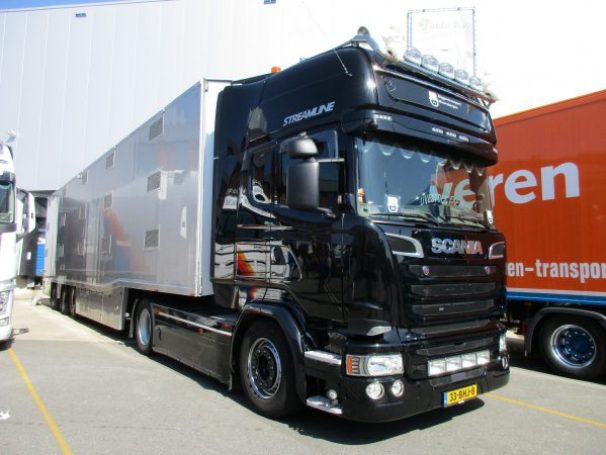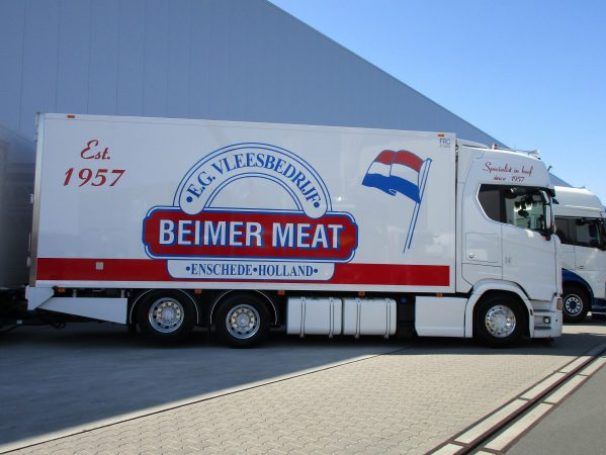When transporting livestock, animal welfare and -health have become top priorities in the recent past. If the driving distance exceeds 65 km/40 miles, then the hauling company needs a license for transporting livestock and the driver must have a special certificate. There are strict regulations concerning the registration of the animals and the cleaning/disinfection of the vehicles. If the trip takes more than 8 hours, then the regulations only get more strict.
The cargo compartments of modern livestock big rigs are fully climate controlled and are equipped with an excellent ventilation- and drinking water system. Last April, when visiting a truck show, I captured a trio of livestock haulers on camera. Vehicles owned and driven by dedicated professionals.
It’s quite obvious that this combination’s job is hauling pigs. The 2017 Scania S520 tractor tows a 2011 Berdex semi-trailer. The national (Dutch) GVM rating for this rig is 46.5 metric tons, yet on a Trans-European trip that would be limited to 40 metric tons.
Here’s a video, featuring a Berdex semi-trailer and the loading process of pigs.
Next is a 2016 Scania R450, it says biggentransport on the front of its high roof. Transporting piglets, in plain English. This is the only Scania with an inline-6 engine (12.7 liter displacement), the others shown here are powered by a stomping 16.4 liter V8.
A different set-up, a 2016 Scania R520 6×2 straight truck with a drawbar trailer. ‘t Komt Goed! is the owner’s slogan. Everything will be alright.
Well then, let’s cut to the chase. After the pig comes pork and after the cow comes beef. And here we happen to have a specialist in beef, since 1957.
What a splendid reefer! A 2017 Scania S730 (as in 730 hp) 6×2 truck with a matching drawbar trailer. Its GVM rating is 50 metric tons, given the fact that the combination has 6 axles. The legal maximum overall length for such a truck-trailer combination is 18.75 m (61’6”).
…’t Komt Goed!…




























The differences between EU and American livestock hauling standards are… astounding.
What’s the translation of the words under Porky Pig?
I do find it interesting that their truck numbering system is based on the vehicle’s HP instead of KW since everything else is metric. I guess old habits die hard.
Lebende Tiere, but the L is missing. It is german for living animals.
And yes old habits die hard. No one is intersted in KW, it is only important on papers.
A small fraction of the L is still there, see? The rig’s owner, Mr. Buurman, frequently brings piggies to our neighbors, I assume. Funny, as “buurman” is Dutch for neighbor…
The official and registered power rating of any vehicle is in kW. Big deal…(kW-rating x 1.36 = DIN-hp)
Nice rigs the 50T truck trailer setup here would be a eight wheeler (four axle twin steer bogie drive) and a five axle trailer, I guess our axle loadings are lighter possibly to cope with our poor roads, the bogie drive with power divider lock and diff locks are required to get into farms for pickups we have lots of very steep country and gravel dirt roads leading into farms that the trucks have to negotiate, they are very hard on the gear, 500hp is about the minimum required these days,
“Bogie drive” (so 6×4, 8×4 and 10×4 chassis) is only used here in logging, heavy-haulage and on/off-road work (dump trucks, mainly).
The rest -thus the vast majority- of the on-highway chassis is 4×2, 6×2, 8×2 or even 10×2. So just one drive axle, even on 700+ hp Scania and Volvo beasts, like the reefer in the article.
Between 500 to 550 hp is today’s most common maximum power output for big rigs, certainly for international haulage. Mostly inline-6 engines with 12 to 13 liter displacement (like the DAF-Paccar MX-13 and the FPT Cursor 13).
Nice trucks Johannes. Scania´s are one of my favourite trucks.
I was into model trains as a kid, and was aware of “reefer” as a slang for refrigerated car, but was not exactly aware of its other meaning as a 10-year-old. I remember looking up HO-scale reefer train cars on Yahoo! (as a 10-year-old in 2001), and could not understand why it was giving me content warnings and wanting me to prove my age…
(Anyone else remember the really buggy and dumb keyword-based filtering of that era that blocked plenty of innocent sites?)
As usual with Holland, everything is clean, clean, clean. The first truck is stunningly beautiful – and clean.
Now let me tell you about driving behind cattle/pig/sheep trucks in Wyoming, Montana, Colorado, western Kansas or western Nebraska. You need plenty of blue fluid in the wiper reservoir. The animal transporters are the dirtiest, most unsanitary, sloppy trucks on the road and driven with no consideration at all to the other users of the road nor for the road surfaces.
“Climate control”, “disinfection”, “water” and “cleaning” are concepts completely unknown in the American west to feed animal transporters.
If animal effluents are not wanted on your car, avoiding a large perimeter around Greeley, Colorado and Ogallala, Nebraska is recommended.
This line of business -dealing and hauling livestock- has fully professionalized in a relatively short time frame. Say in the past 10 to 20 years. Local cattle markets have become folklore, something from the past. And we had many of them, certainly for such a small country. All gone.
In the old days, livestock trucks used to be as dirty and muddy as dump trucks. Unacceptable now.